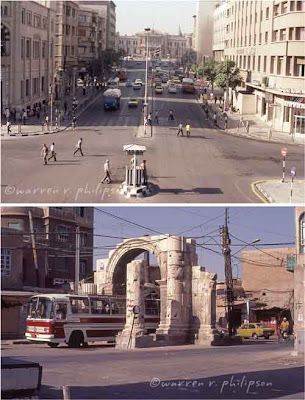 |
Damascus, 1982. Business section (top);
Roman arch and columns in old Damascus.
|
Welcome back. Syria is in the news for all the wrong reasons. Do you remember my writing how cool it was to be in Rome and sleep a 10 minute walk from the Colosseum? In Syria, you’ll probably sleep farther from major Roman ruins, but they’re there, along with an incredible catalog of other sites and sights. May I give you a taste?
Because my time in Syria was 30 years ago and this isn’t a book, I’ll stick with highlights. For today’s post, I’ll stay in the capital, Damascus, one of the world’s oldest cities.
 |
Damascus from a hotel’s 8th floor.
|
The Background
Working as a UN consultant on an agricultural monitoring project, I visited Syria three times for stays of about 2 to 4 weeks each.
When I landed in Damascus, I was, as usual, unprepared to be a tourist. No problem. The hotel provided a map, albeit in French, and the collaborating government groups’ hours were 8 AM to 2:30 PM, Saturday to Thursday, leaving me time to roam. Later, I purchased and promised to read a few locally produced guides.
Wandering Damascus
Mosques are everywhere, one more strikingly beautiful than another. The first I visited was the mid-16th century, Tekieh Suleimanieh Mosque, located across from the National Museum.
 |
| Damascus mosques and minarets, 1982. |
 |
| Tekieh Suleimanieh Mosque, Damascus. |
(The National Museum is highly rated. On my visit, however, I paid the small entrance fee, couldn’t take my camera inside, and discovered any signs were in Arabic and French, the upper floors were closed and a bribe was required to access one exhibit. That was a long time ago.)
I soon found the Umayyad Mosque--the “Great Mosque,” which dates from the 7th century and is one of the largest mosques in the world.
 |
|
Umayyad or Great Mosque, Damascus. An entryway
and the Dome of the Treasure in the courtyard.
|
While you couldn’t miss the mosque on the map, I kind of stumbled upon it after walking through the Souk Al-Hamedieh, a covered street of shops selling this, that and more. One end of the souk opens onto a Roman arch and, a bit farther, the mosque.
 |
Shrine of John the Baptist inside
prayer hall of Umayyad Mosque. |
 |
Souk Al-Hamedieh,
Damascus, 1982
|
 |
Ends of Souk Al-Hamedieh, Damascus.
One end (semicircular roof, left photo)
is on a major street; other end opens
to a Roman arch and Umayyad Mosque.
|
 |
A Roman arch on Straight
Street, Damascus.
|
Another major souk in old Damascus occupies part of Straight Street, which runs nearly a mile to Bab Sharqi, one of the seven gates in the ancient Damascus wall.
 |
Bab Sharqi (Eastern Gate) is by the minaret.
The dome is the Orthodox Armenian Church. |
 |
St. Paul’s Chapel near Bab Sharqi, Damascus.
|
 |
Goldsmith shops, Damascus.
|
There were gold jewelry shops everywhere. On the north and south sides of old Damascus, competing vendors seemed to congregate–souks with musical cassette players blaring away, souks with animal pelts, tailors under beach umbrellas.
 |
Tailors outside old
Damascus wall.
|
Vendors sold prickly pear on every busy corner. (Earlier
posts featured photos of a prickly pear vendor, glassblower and baker.) Other vendors displayed jewels, colorful stones or simply gum on sheets or rugs spread on the street.
 |
North wall of Damacus.
|
 |
| Bab el Saghir Cemetery and tombstone-maker’s shop. |
South of old Damascus, I passed a large cemetery crammed with tall, thin tombstones, possibly made in a shop I saw elsewhere.
Wrap Up
And that’s a taste of Damascus. There’s so much more of course. Thank you for stopping by. Come back in about a week, and I’ll take you on a day trip to places in Syria that knocked my socks off. As usual, I’ll post a photo addendum earlier.
Oh, the emailed version of this post and any with lots of photos interspersed with text will likely be ill-formatted. Please check the blog.
P.S.
The Damascus guidebook I purchased in 1982 is Shaban, F. 1976. Syria–A tourists’ guide. Alef-Ba’ Al-Aldeeb Press, Damascus. 128 pp. After comparing details and discussion with Wikipedia and other websites, and noting that newer guides are available, I can’t recommend Shaban’s book.

No comments:
Post a Comment